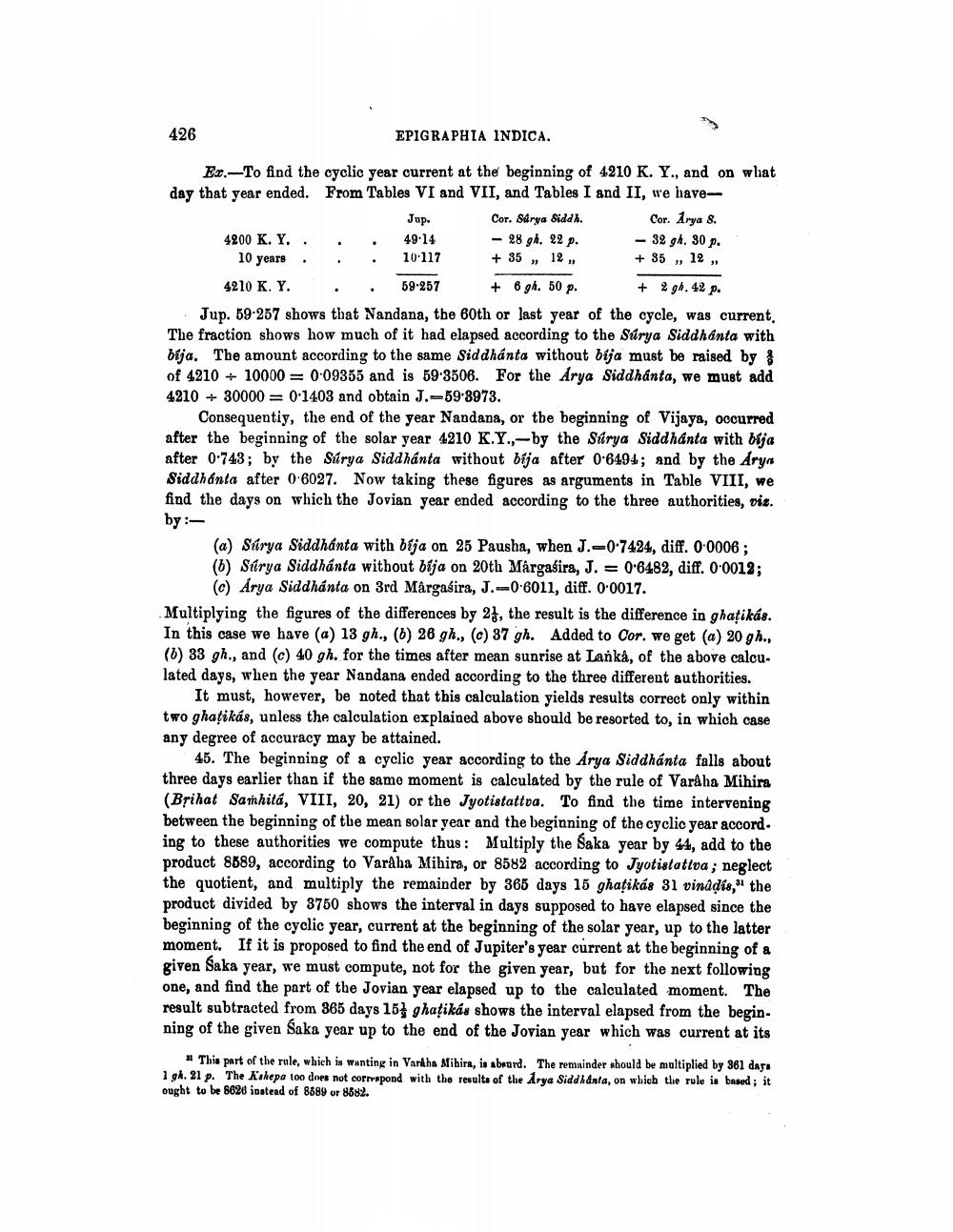________________
426
EPIGRAPHIA INDICA.
Jap.
Ex.-To find the cyclic year current at the beginning of 4210 K. Y., and on what day that year ended. From Tables VI and VII, and Tables I and II, we have
Cor. Sarya Sidda. Cor. Arya 8. 4200 K. Y. . . . 49.14 - 28 gk. 22 p. - 32 gh. 80 p.
10 years . . . 10:117 + 35, 12, + 85 , 12, 4210 K. Y. . 69.257 + 8 gh. 50 p. + 2gh. 42 p. Jup. 59-257 shows that Nandana, the 60th or last year of the cycle, was current. The fraction shows how much of it had elapsed according to the Súrya Siddhanta with bija. The amount according to the same Siddhanta without bija must be raised by of 4210 + 10000 = 0·09355 and is 59-3506. For the Arya Siddhanta, we must add 4210 + 30000 = 0-1403 and obtain J.-59-8973.
Consequentiy, the end of the year Nandana, or the beginning of Vijaya, oocurred after the beginning of the solar year 4210 K.Y.,-by the Sarya Siddhanta with bija after 0-743; by the Súrya Siddhanta without bija after 0:6494; and by the Arya Siddhanta after 0-6027. Now taking these figures as arguments in Table VIII, we find the days on which the Jovian year ended according to the three authorities, diz. by :
(a) Súrya Siddhanta with bija on 25 Pausha, when J.-0-7424, diff. 0.0006; (6) Súrya Siddhanta without bija on 20th Margasira, J. = 0.6482, diff. 0·0012;
(c) Árya Siddhanta on 3rd Mârgasira, J.-0:6011, diff. 0:0017. Multiplying the figures of the differences by 24, the result is the difference in ghatikás. In this case we have (a) 13 gh., () 26 gh., (c) 37 gh. Added to Cor. we get (a) 20 gh., (6) 33 gh., and (c) 40 gh. for the times after mean sunrise at Lankå, of the above calculated days, when the year Nandana ended according to the three different authorities.
It must, however, be noted that this calculation yields results correct only within two ghatikás, unless the calculation explained above should be resorted to, in which case any degree of accuracy may be attained.
45. The beginning of a cyclio year according to the Arya Siddhanta falls about three days earlier than if the same moment is calculated by the rule of Vardha Mihira (Brihat Samhitá, VIII, 20, 21) or the Jyotistattva. To find the time intervening between the beginning of the mean solar year and the beginning of the cyclic year accord. ing to these authorities we compute thus: Multiply the Saka year by 44, add to the product 8689, according to Varaha Mihira, or 8582 according to Jyotistattva; neglect the quotient, and multiply the remainder by 365 days 15 ghatikás 31 vinadís," the product divided by 3750 shows the interval in days supposed to have elapsed since the beginning of the cyclic year, current at the beginning of the solar year, up to the latter moment. If it is proposed to find the end of Jupiter's year current at the beginning of a given Saka year, we must compute, not for the given year, but for the next following one, and find the part of the Jovian year elapsed up to the calculated moment. The result subtracted from 365 days 15} ghaţikás shows the interval elapsed from the begin. ning of the given Saka year up to the end of the Jovian year which was current at its
This part of the rule, which is wanting in Varkha Mibira, is abeurd. The remainder should be multiplied by 861 daya 1 gh. 21 p. The Kshepa 1oo does not corrrepond with the results of the Arya Siddhanta, on which the rule is based; it ought to be 8620 instead of 8689 or 8682.




